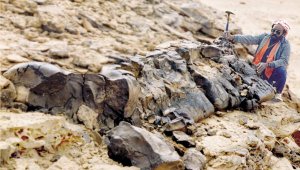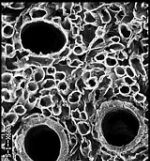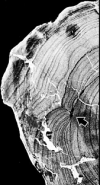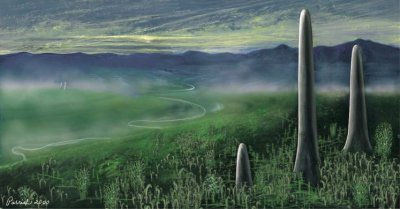Science Daily ran an interesting summary about researchers verifying the identity of a giant organism found in the Devonian. I’ve always had a soft spot for the Devonian since the rocks in my hometown in Michigan are all from that period so I thought I’d take a look. Even without the childhood memories of brachiopods and trilobites, the Devonian is a pretty cool period in time from about 410 to 360 million years. In the ocean, nautilus-like ammonites flourished while the first bony fish and sharks evolved and radiated. On land, the Devonian started empty with only bacterial and algal mats covering the ground. By the end of the Devonian, forests of ferns and trees populated by insects and other arthropods were flourishing while our tetrapod ancestors took their first steps on to land. Between these two extremes of lush forests and barren ground, an organism whose identity remained unknown for a hundred years after it’s discovery developed and towered over the landscape.

The first scientist, J. W. Dawson, to describe these fossil “logs” (like the picture to the left) thought they were palm tree-like plants and classified them as ancestors of conifers Prototaxites (Taxus is a genus of conifers). When Dawson presented his work in 1870, another scientist attacked it saying that the organism must be a form of giant algae and tried to illegitimately rename the genus. Dawson defended his decision for a while and then silently about-faced, renamed the genus (also illegitimately) and said he had never meant that to imply a relation to conifers. Although there were some suggestions for other classifications, the genus remained largely identified as an algae until 2001 when Hueber published a definitive 36 page paper on the subject.

Hueber painstakingly tracked down the original notes and specimens of Dawson and the others involved and collected many new specimens. After careful examination, he determined that Prototaxites were actually giant fungus based on the hyphae (basic fungal cells) visible in microscopic examinations. It’s really amazing the detail that is preserved in these fossils. The picture to the right is magnified 600 times and shows the characteristic hyphae. Interestingly, Dawson’s notes reveal that he had observed that several features of the fossils looked like fungus but assumed that this was due to mushrooms growing on the ‘tree’ after its death.

Another cool thing about these fossils is that they appear to have growth rings like trees. Looking at these rings, it becomes pretty understandable that Dawson would think the fossil was a type of tree. In the piece to the right, evidence of damage, perhaps from a primitive insect, is even evident in the growth rings. Hueber suggests it may have been the rise of fungus eating insects that drove the Prototaxites to eventual extinction.
To top all of Heuber’s research off, the recent paper by Boyce and others (including Heuber) manages to verify that Prototaxites are fungus by looking at the carbon-12:carbon-13 ratio. Different types of plants produce differing ratios of these two isotopes of carbon. By analyzing the ratio of these two carbons in animal tissues, scientists can tell what types of plants an animal eats or what types of plants its prey eat. I had heard of people analyzing the diet of seals and other animals by looking at the carbon ratios in their tissue and I remember reading you can tell Americans from Europeans by differences in carbon ratios resulting from eating sugar beets or sugar cane (although I can’t find a reference for this now) but I never realized you could analyze fossils using carbon ratios. It’s pretty cool to know that the carbon in ancient plants and animals can be directly preserved in fossils and coal today. If Prototaxites were algae or plants, then they would be expected to have a fairly consistent carbon ratio since plants create their own carbon compounds from photosynthesis. In contrast, the researchers found a broad range of carbon ratios in the Prototaxites they sampled. This suggests that Prototaxites were fungus feeding on microbial mats rich in carbon-13 in some areas and on plants rich in carbon-12 in other areas.
For 50 million years before there were trees or vertebrates on land, these fungi towered as high as a house above the landscape. Each individual likely grew acres and acres horizontally digesting organic matter slowly and undisturbed perhaps for hundreds or thousands of years before growing these huge structures to spread their spores on the winds to other favorable locations. Through these scientists detective work we can understand and imagine it.

References
F. M. Hueber. 2001. Rotted wood–alga–fungus: the history and life of Prototaxites Dawson 1859. Review of Palaeobotany and Palynology. 116:123-158
C. K. Boyce, C. L. Hotton, M. L. Fogel, G. D. Cody, R. M. Hazen, A. H. Knoll, F. M. Hueber. 2007. Devonian landscape heterogeneity recorded by a giant fungus. Geology 35:399-402
Cogmios | 12-Jul-07 at 3:54 am | Permalink
Wow, absolutely amazing these fungi! What a legendary period this must have been, the Devononian period and how sad Perm ended… Wouldn’t it be cool if we could send a camera to back then and just make some footage of this period?